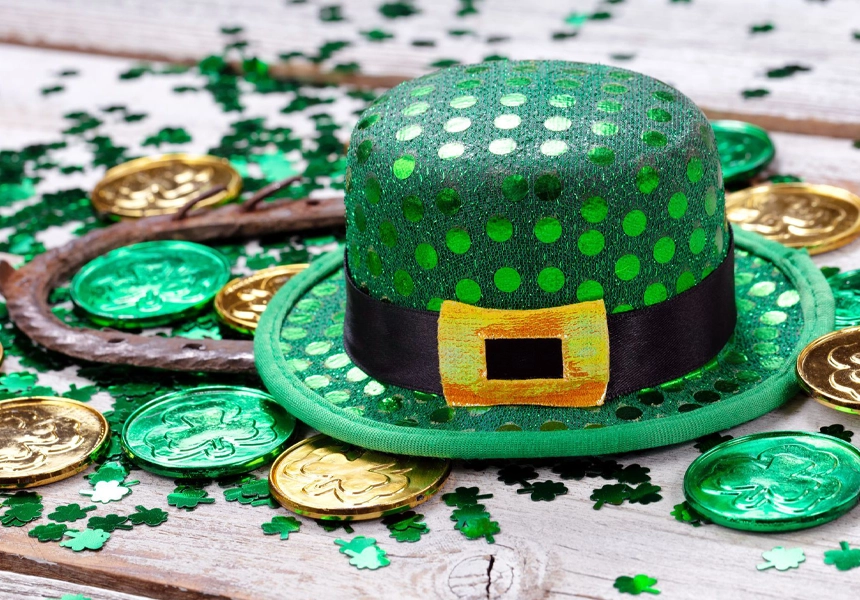Topical Talkers
Surprising Facts About St. Patrick’s Day.
While St. Patrick’s Day is now associated with wearing green, parades and lots of beer, the holiday is grounded in history that dates back more than 1,500 years. The earliest known celebrations were held in the 17th century on March 17, marking the anniversary of the death of St. Patrick in the 5th century.

The Real St. Patrick Was Born in Britain
Much of what is known about St. Patrick’s life has been interwoven with folklore and legend. Historians generally believe that St. Patrick, the patron saint of Ireland, was born in Britain (not Ireland) near the end of the 4th century. At age 16 he was kidnapped by Irish raiders and sold as a slave to a Celtic priest in the area now known as Northern Ireland. After toiling for six years as a shepherd, he escaped back to Britain. He eventually returned to Ireland as a Christian missionary.
St. Patrick Was Never Canonized
Despite his status as a patron saint, St. Patrick was never actually canonized by the Church during his lifetime. This was primarily because such a process did not exist when he died in A.D. 461. It wasn’t until 993 that St. Ulrich of Augsburg became the first saint to be formally canonized, and it was not until the 12th century that the Church established an official canonization process overseen by the Pope. While St. Patrick has not been formally canonized, many consider him to hold saintly status.
There Were No Snakes Around for St. Patrick to Banish from Ireland
Among the legends associated with St. Patrick is that he stood atop an Irish hillside and banished snakes from Ireland prompting all serpents to slither away into the sea. In fact, research suggests snakes never occupied the Emerald Isle in the first place. There are no signs of snakes in the country’s fossil record. And water has surrounded Ireland since the last glacial period. Before that, the region was covered in ice and would have been too cold for the reptiles.
Leprechauns Are Likely Based on Celtic Fairies
The red-haired, green-clothed Leprechaun is commonly associated with St. Patrick’s Day. The original Irish name for these figures of folklore is “lobaircin,” meaning “small-bodied fellow.” Belief in leprechauns likely stems from Celtic belief in fairies tiny men and women who could use their magical powers to serve good or evil. In Celtic folktales, leprechauns were cranky souls, responsible for mending the shoes of the other fairies.
The Shamrock Was Considered a Sacred Plant
The shamrock, a three-leaf clover, has been associated with Ireland for centuries. It was called the “seamroy” by the Celts and was considered a sacred plant that symbolized the arrival of spring. According to legend, St. Patrick used the plant as a visual guide when explaining the Holy Trinity. By the 17th century, the shamrock had become a symbol of emerging Irish nationalism.
Ireland’s Only Female Patron Saint, Brigid, Has Her Own Holiday
One of Ireland’s three patron saints, alongside St. Patrick and St. Columcille, St. Brigid (or Bridget) is the patron saint of Irish nuns, newborns, midwives, dairy maids and cattle. Believed to have been born in Ireland sometime around A.D. 450, Brigid was the daughter of a pagan king and an enslaved woman. She grew up to serve the church by building a church in Kildare, which was the site of a former shrine to the Celtic goddess, eponymous to her.
The First St. Patrick’s Day Parade Was Held in America
While people in Ireland had celebrated St. Patrick since the 1600s, the tradition of a St. Patrick’s Day parade began in America and actually predates the founding of the United States. Records show that a St. Patrick’s Day parade was held on March 17, 1601, in a Spanish colony in what is now St. Augustine, Florida. The parade and a St. Patrick’s Day celebration a year earlier were organized by the Spanish Colony’s Irish vicar Ricardo Artur. More than a century later, homesick Irish soldiers serving in the English military marched in Boston in 1737 and in New York City on March 17. Enthusiasm for the St. Patrick’s Day parades in New York City, Boston and other early American cities only grew from there.
The Irish Were Once Scorned in America
While Irish Americans are now proud to showcase their heritage, the Irish were not always celebrated by fellow Americans. Beginning in 1845, a devastating potato blight caused widespread hunger throughout Ireland. While approximately 1 million perished, another 2 million abandoned their land in the largest-single population movement of the 19th century. Most of the exiles nearly a quarter of the Irish nation came to the shores of the United States. Once they arrived, the Irish refugees were looked down upon as disease-ridden, unskilled and a drain on welfare budgets.
Corned Beef and Cabbage Was an American Innovation
The meal that became a St. Patrick’s Day staple across the country corned beef and cabbage was an American innovation. While ham and cabbage were eaten in Ireland, corned beef offered a cheaper substitute for impoverished immigrants. Irish Americans living in the slums of lower Manhattan in the late 19th century and early 20th purchased leftover corned beef from ships returning from the tea trade in China. The Irish would boil the beef three times the last time with cabbage to remove some of the brine.